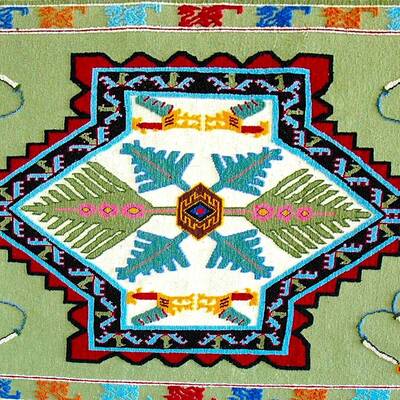Shiriki Pich Kilims of Sirjan
One of the oldest handicrafts of Iran are Kilims and historical documents prove that they go back to more than five thousand years ago. Kilims are originally flat weaves that are made without using knots, but according to the Dehkhoda word encyclopedia it is also used as clothing.
Kilims have mostly been the profession of the nomads from many years ago, especially in southern regions of Iran. Sirjan, a city in the south of Kerman province, is now famous for its Kilims. High quality and innovations in patterns and colors of Sirjan Kilims resulted in the registration of this city as the global city of handwoven Kilim by the World Council of Handicrafts. Unlike common Kilims, Shiriki Pich or Suzani Kilims of Sirjan which earned this city its fame, are knotted weaves and considered an intermediate between carpets and Kilims. It is believed that they were invented when the Afshar and Bughachi clans entered Kerman and later during Afsharid dynasty. There are many theories about naming of these Kilims. One is that Shiriki Pich is a cover for horses which refers to its first usage. On the other hand, “Pich Bafi” is a kind of Kilim, and “Shiriki” can refer to the type of the Shiriki knot that are double knots, or it can indicate that the product was weaved by two persons. Like many other Kilims, they are woven by wool yarns. The loom is similar to the looms of carpets, and the technique is similar to the technique of carpet weaving. There are two primary knots for Sirjan Kilims, one is “Matn” and the other is “Abduzi”.
In these weaves, unlike other Kilims, the weft plays no role in making the patterns but it is the wraps that creates them. This Kilim is rarely woven based on a premade pattern. It can be said that almost all Sirjan Kilims are unique and no two similar pieces can be found. The backgrounds are mostly cream, milky white, red, blue and dark blue. It is possible to describe these incredible hand weaves by the word “Hessi Baf” or sensational weave, because the mood and emotions of the weavers, who are nomad women, affect even their choice of color during the production.
The motifs come in various colors. Kinds of green, yellow, pink and blue are used to make geometric and semi-cursive motifs and motifs of fish, giraffe, and birds like the stork, sparrow, peacock and etc. It is rare to find a Sirjan Kilim plain and without any motif. Herbal and animal pigments such as Cochineal and Vermilion worm are mixed with oxides of metals to dye the yarns. “Gol-o-Godani”, “She Kaleh”, “Kuh Panj”, “Bandi Lozi”, “Kheshti” or “Ghalebi” and paisley are some of the most common motifs of Shiriki Pich Kilims. Today, in addition to making bags, chair covers, and wall hanging, they are considered an important non-oil export of Iran due to their international popularity.
